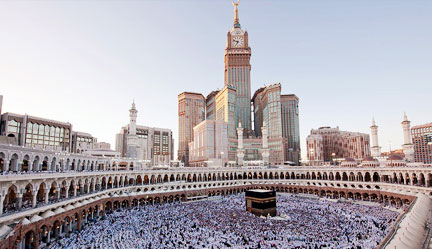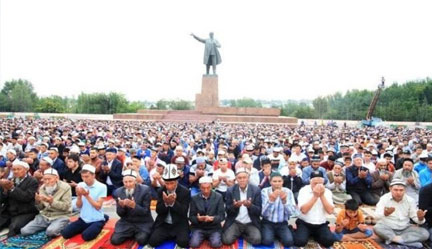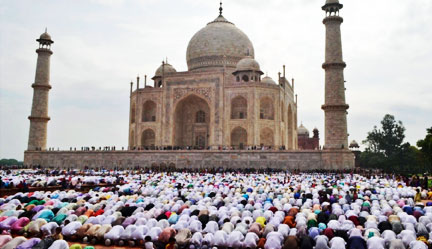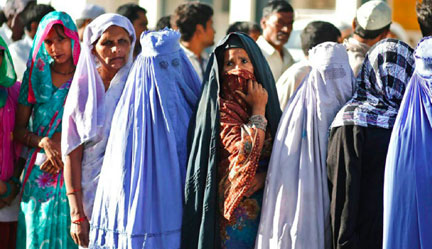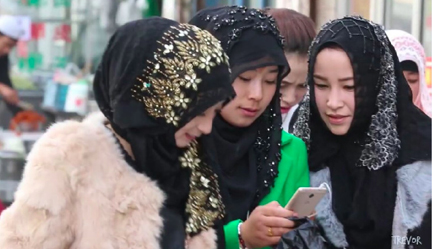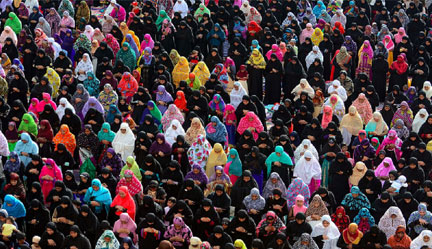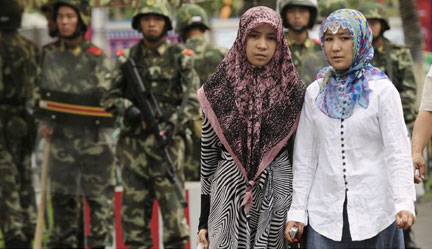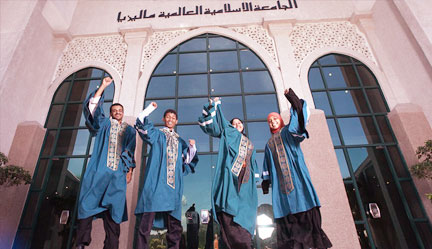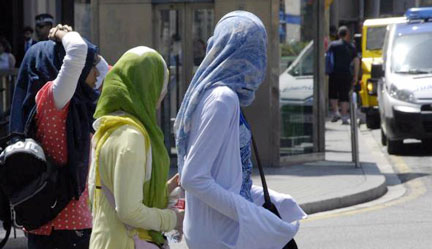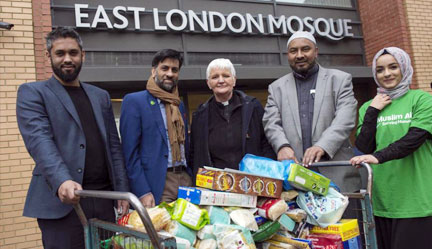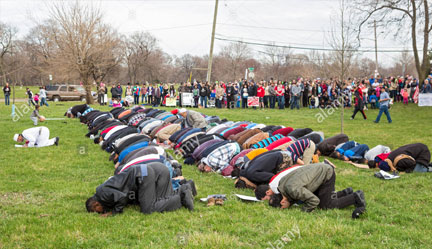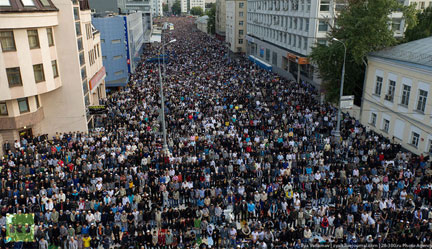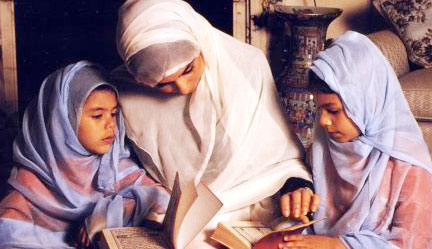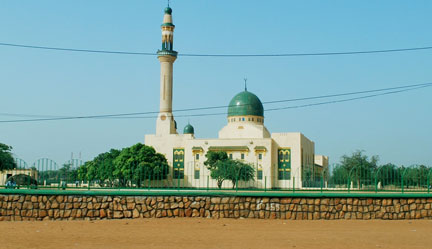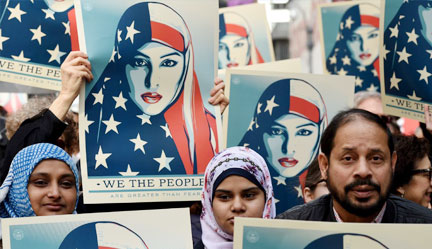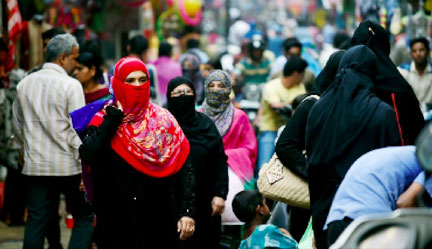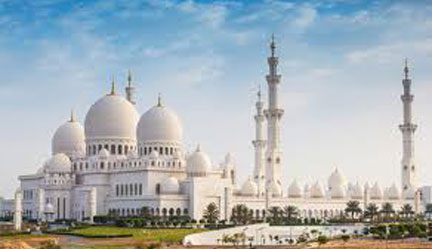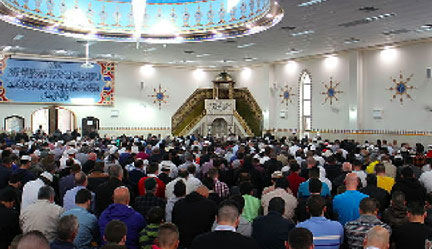These articles aim the problems and issues that currently exist in the present communities of Muslims.
Introduction
Muslims are approximately 25 percent of world’s population. Beside South Asia and North Africa regions that were the primary Muslim societies, Islam is followed by a wide range of people in various and numerous present-time countries, who consider themselves attached to a great family called “Umma”, as a Quranic term. Muslims consist the majority in some countries, even rarely they have obtained the authority and governed them; Although, they have formed a society alongside other religions adherents societies to have the efficient role within several countries or have tried to live as a minority in rest cases. Additionally, Muslims are the fastest-growing religious group in the world; According to latest population surveys findings, one out of three children born from 2010 to 2015 were Muslim. Also, assessments estimate that babies born to Muslims are expected to outnumber those to Christians by 2035.
Asia
Islam is currently the largest religion in Asia followed by Hinduism and this continent is home to the largest Muslim population, about 1.1 billion (62% of the world’s Muslims). The spread of Islam outside of the Arabian peninsula and Middle East region has the highest percentage of Muslim-majority countries, and into other parts of Asia can be linked to the extensive trade routes connecting West Asia to China. Throughout history, Muslim cultures of Asia have been diverse ethnically, linguistically and regionally.
The centrality of sharia in the Islamic societies of the ancient continent does not necessarily correlate with the size of the population and the ethnic dispersion of Muslims in different countries and regions. Although Islam historically has come to be found among Arab peoples, the Muslim majority or the recognition of Islam in the community is not specific to Arab countries, and in some cases, like Lebanon and the United Arab Emirates, Muslims account for just over half of the Arab population make. Conversely, Muslims from the majority of the population are among the many non-Arab countries (including Iran, Afghanistan, Turkey, Maldives and Azerbaijan). In addition, the comparison between the number of Muslims in China and India, which has populations of 50 and 200 million Muslims, is with small countries in which Muslims form the overwhelming majority of the population, suggesting a variety of issues and discourses that the number of Muslims in a community, as well as their share of the total population, is relevant. In other words, there must be a difference between the relationships, needs and concerns that exist among the “Vast Minorities” and “Muslim Minorities in Asia” in relation to the Sharia. If the enjoyment of religious freedom and the elimination of discrimination is a first-class issue (Muslim vast minorities), the effort to include the provisions of the Sharia in the official law of the country is certainly among the concerns of the second type (Muslim small majority), and thus, in addition to the element of number and The population, the proportion of Muslims to other groups in a community, also contributes to the formation of their collective identity, and forms part of a wide variety of Islamic communities throughout this vast continent.
Modern discourses and topics such as women’s rights, religious-religious tensions, democracy and religious freedom, extremism and terrorism constitute other dimensions of the cultural diversity of Muslim Muslims in Asia. At least half of the Muslims in some Asian countries (67% in Egypt and the same in Tunisia, 68% in Iraq, 78% in Indonesia) reportedly worry about the activity of extremist religious groups, according to the Pew Research Center on Muslims in the world in 2013, Concerned over radical Muslims over Christian extremists is reportedly worse in their country. Also, while there is an agreement among Muslims around the world about the immorality of some behaviors such as homosexuality, suicide, abortion, euthanasia, and alcohol consumption, there is a marked difference between Asian Muslim societies about some things like polygamy, divorce, control of the population as well as women’s rights. Although nearly half of the Muslims in Occupied Palestine and Malaysia in the westernmost and easternmost parts of the continent of Asia consider polygamy as morally acceptable, more than 60% of Central Asian Muslims, This is opposed, while the percentage of opposition to polygamy in the drawer Other, covers the whole range of different opinions. However, in some cases, such as women’s rights, it seems that there is a great deal of similarity among Muslims in Asia (as compared to other parts of the world). For example, 93% agree in Southeast Asia, 70% in Central Asia, 88% in South Asia, and 87% in the Middle East, with the idea that they should comply with her husband’s choice of female dress.
Political conditions governing Islamic societies and their position towards the West are also effective in a variety of Sharia discourses; although, according to previous polls, there are different perspectives on the role of religious leaders in society and their impact on political issues. In a general estimation, regardless of the countries in which the majority Muslims are in government, there are significant minorities in different regions of Asia (37% in Jordan, 41% in Malaysia and 53% in Afghanistan) by taking on major political roles by religious leaders Agree. In the end, one must point out the challenges among the followers of the Islamic sects, and its significance in the diversity of sharia discourses on the continent of Asia, along with attempts to identify Muslims against rival and secular groups.
Middle East
The term “The Middle East” derived from a European perspective and for some it refers to the area bounded by the Mediterranean sea, the Arabian Peninsula and the Taurus and The Zagros Mountains. For others, it refers to Egypt, Arabia, and the Persian Gulf States. Others use the term as a synonym for the Arab world, sometimes including Turkey and Iran. However, it seems the “Middle East” refers to the regions were the primeval states of Islam.
People often assume that the Middle East is comprised solely of Arabs and that the three Abrahamic faiths are the only religions to be found in the region. But in fact, there are many more ethnicities and religions in the Middle East: some of these include Turkics, Kurds, Armenians, Azeris, Assyrians, Turkmens, Persians and different Bedouin communities whose origins reside in African and Asiatic countries. Similarly, Zoroastrian, Bahá’í, and Yazidis are some of the religions to be found in the Middle East today, in addition to Judaism, Christianity, and Islam (in their many branches and traditions).
In spite of this diversity makes the strong cultural backgrounds for nations of Islam in the middle east, the original split between Muslims has widened to encompass social, political and theological differences. The main underlying beliefs and principles of Islam remain the same in both the Sunni and Shia streams. However, the challenges and conflicts between Shia and Sunni Muslims in Iraq after US militarian attack and the fall of Saddam increasingly spread the religious, social and political variances to Iran, Lebanon, Syria, and the other Muslim nations and redouble the violence. Similarity, mainstream Muslims, Sunni, and Shia, do not accept some of these groups as Muslim. In Pakistan, for example, the government has declared that the Ahmadis – who believe that their founder, Mirza Ghulam Ahmed, was a prophet after the death of Muhammad (PBUH) – are non-Muslims, despite the fact that the Ahmadis themselves identify as Muslims. The story of Muslim diversity is an intensely complex one which has sometimes led to conflict and violence. On the one hand, there is the desire and push to homogenise Islam and bring consistency and consensus among all Muslims. On the other hand, there are real differences in how Islam is interpreted and practised. This dilemma appears endemic to most religions and can be seen in Christianity for instance, following the split between Catholics and Protestants.
The evolutions based on the West interfering that occurred in the Middle East over the course of the 20th, more than any other factor, generally made the current circumstances of the middle east Muslim communities. Events and implications of the occupation of Palestine and the announcement of the existence of Israel supported by the United Kingdom, as well as political interference in Iran in order to benefit from the economic benefits of the new discoveries of oil during the Cold War on the part of the United States which ultimately led to the 1979 revolution Iran, in the years to come, provided an enabling environment for the emergence of nationalism and fundamentalism. Western interventions after this period have always been a growing factor for sectarian challenges among Muslims in the Middle East. This process, with the direct US military operation in Afghanistan and then in Iraq, reached a stage when, after the political change called the Arab Spring, the phenomenon of “ISIS” came to a halt, a crisis that could be confronted with an allusion to Arab nationalism. Shi’a and Sunni, as well as international terrorism. On the one hand, ISIS’s experience, on the one hand, contrasts with the traditional forms of efforts to revive and enforce the Sharia in the Middle East, which Saudi Arabia and Iran represented in the dual Sunni and Shiite delegates, and on the other hand, influenced by the effects of globalization, Ignoring the boundaries of the climate and cultural capital. Consequently, irrespective of the devastation and consequences of the violence that arose in a large part of the Middle East, ISIS’s rise and fall created new challenges in the development of Sharia discourses and the forming and supporting ideas of Islamic societies.
Taken together, and given the fact that most of the Middle Eastern countries have a Muslim majority, political and political conflicts can be considered as a decisive element in the Sharia discourse and a key factor in the developments in the region, including the continuation of religious unrest and violence in Afghanistan. And Pakistan, the continuation of political rule of Islam in two opposing faces of Iran and Saudi Arabia, the emergence of ISIS and the emergence of a new wave of terrorism in Syria and Iraq, political integration and multilateralism in Turkey, and finally the challenges of Islamists and rival forces in shaping the future of Egypt.
Saudi Arabia
Saudi Arabia is the birthplace and life of the Prophet and the incarnation of Islam, and is also a country that is most sensitive to the application of Sharia law in the absence of the customary civil system, in such a way that the laws of the Sharia can be considered as the constitution Country. They are now whimsical with Saudi citizens as well as the majority of foreign nationals working or residing in this Muslim country.
Sharia law is obligatory in Saudi Arabia, and this is compelled by the government and by a special force called “muṭawwiun”. The pursuit of law-makers and the execution of religious punishments, including arresting, scourging, imprisoning, and killing them are one of the responsibilities of this religious police. The scope of compulsory adherence to the religious law of foreigners also encompasses the number of foreign offenders crammed during the year, which is higher than the number of Saudi citizens. Also, non-Muslims will not be allowed to perform their religious rites in Arabia, where Islam is the only sacred and permitted religion. None of the manifestations of other religions, such as churches or Christmas, cannot be present in Saudi Arabia, and all people should eat halal food and observe the limits of Ramadan. Despite these conditions, while the change in the religion of Saudi citizens leads to a religion other than Islam punishable by death, the Saudi government broadly supports the spread of Islam in other countries and the conversion of other followers of religions to Islam and is backed by financial resources Oil-sourced from many mosques and schools throughout the world, including the United States.
Regardless of the extent and severity of Sharia laws in Saudi Arabia, some restrictions apply to women who have often been seen as cultural but seen from sharia law. Except for the hijab and the traditional type of traditional cover, women are almost men in guardianship, and in spite of the lack of statutory writing, in practice every woman has to perform a large part of social affairs, such as traveling, getting a passport, marriage, and divorce, and signing a contract, one “Wali” that is father, brother, uncle or spouse; it is almost impossible for women who have been victims of domestic violence or abusive practices, despite the adoption of new restrictions, such as the need to allow a university to go to university, or to abolish employment or surgical procedures. Sexuality can regulate a complaint even against them without the consent of their legal guardian And keep track of it. Except for men’s legal guardianship, women in Saudi Arabia are faced with a wide range of restrictions on the use of public services, the enjoyment of citizenship rights and identity papers, marriage, divorce and family rights, educational and employment opportunities, driving and office positions. In recent years, significant efforts have been made to reduce them, either from civilians or from the government. Today, Saudi women, especially teenagers and young people, are looking for new ways of living that keep their belonging to modernity and national identity and develop as much as possible.
The balance between the religious wing (which in particular represents Wahhabism and Salafi thought in Islam) and the political faction (which has placed power and economy in the hands of the Saud dynasty) is the focus of stability in Saudi Arabia. Creating a vision of Saudi Arabia in 2030 and the subsequent commands of the new ruler, Prince Mohammed bin Salman, have raised many questions regarding the future of the traditional Muslim community in Saudi Arabia. The policy of “returning to moderate Islam”, which has recently been at the mercy of the government and has led to developments in the application of Sharia law in relation to non-Muslims and women, is completely different from the traditional traditional approach. Although there is still no visible response from the religious wing of Saudi Arabia (which is known as irrational, at least in the field of theology and righteousness), the shift in government policy in the eyes of conservative scholars and religious and judicial authorities in this country seems challenging.
In Saudi Arabia, due to the annual gathering of Muslims around the world at Hajj ceremonies and the long history of this land in Islamic history, there was always a sense of unity and centrality, and Sharia discourse has never been overlooked. Regardless of the societal and modernizations that are taking place in this country, the question of the relation between this role and the long-standing feeling of new developments is the most important issue in the contemporary Saudi discourse.
Iraq & Syria
The part of the Middle East territories that are present in the countries of Iraq and Syria has a significant racial and religious diversity. Arabs and Kurds are considered to be the largest tribes and Sunni and Shiite Islam have the most followers. In the situation where more Kurds live in Iraq, the majority of Syrian Muslims are Sunnis, and Shiites are considered to be the most populous religious group in Iraq, in contrast to the presence of Shiite Imami and Ismaili Shiites in this country.
The two countries are among the oldest and most famous countries in the history of Islam, and political conflicts between Muslims in the first century AD were transmitted to these two regions and continued in Iraq and Syria. In the following period, there are numerous influential figures, currents, and governments in these areas, and there are mosques, buildings and important tombs in these areas. In the constitution of both countries, Sharia and Islamic law are among the sources of civil law, and the Sharia, both in the courts and the official authorities, as well as in the common culture and customs, is respected and respected. Nevertheless, the political developments of recent years have made these two countries the most controversial issue of the Sharia in the world, and the rise of ISIS (the Islamic State of Iraq and the Syria) has completely changed their situation. The emergence and decline of this terrorist organization, based on a fundamentalist interpretation of the teachings of the Salafi Sunni, not only destroyed huge economic, cultural and social assets in Iraq and Syria, with deep theoretical challenges regarding the implementation of the laws of sharia in contemporary Islamic societies and It has provoked unacceptable consequences for the use of violence in the process.
Regardless of the complexity of ISIS’s political and military issues, which embraces a wide range of regional and international debates, and beyond the intellectual and historical context of its formation in the region, the terrible experience of a military effort to enforce the laws of the Sharia is a matter of great importance. Although the controversy between moderate groups and extremist movements over the implementation of the laws of Sharia in Islamic societies has always been in place, the unimaginable volume and variety of violence used by Islamic State to enforce Islamic law is roughly condemned by all groups and among all Muslim communities. Became The armed attack on non-Muslim minorities, the massacre of individuals, the enslavement of women and the forced displacement of survivors are among the most commonly reported behaviors reported by ISIS. Destruction of cultural bases and numerous ancient monuments in the cities of Hatra, Nimrod, Khorsabad, Palmyra and other areas, as well as the destruction of museums, libraries, churches, temples, and even mosques in different parts of Syria and Iraq, on the pretext of confronting idolatry from other ISIS actions. It was aimed at expanding the law and implementing Islamic law in the areas under its control. ISIS also claimed responsibility for numerous terrorist incidents in Europe and the United States, in which hundreds of ordinary people were killed and wounded by bombing or other forms of terrorist attack. The intensity of the violence was so high that even other Islamic extremist groups, including al-Qaeda, which had previously assumed responsibility for the incidents of September 11, 2001, attacked the towers of the World Trade Center in the United States, described ISIS as a symbol of barbarism and criticized its violent practices.
Despite the anti-Western and even anti-Western aspects of most of the currents and movements that demand the maximum presence of sharia in their societies, the existence of two prominent features in ISIS has distinguished it from other similar examples; first, the utilization of technological tools and devices of the day and Second, a significant presence in the global economic and media exchanges network. ISIS, which can be called the richest terrorist organization in the world, on the one hand, emphasized the strict implementation of Shariah with the aim of returning to the earlier desirable position at the dawn of Islam and, on the other hand, using financial resources derived from oil and human trafficking and the domination of capital The Iraqi and Syrian nationalities benefit from the most advanced military equipment, weapons and communication tools. Also, the demonstration of violent acts of ISIS in news channels, social networks and international messengers contributed to the belief that the establishment of Islamic caliphate and the implementation of the Sharia laws would be the only symbolic cover for political adventures and the pursuit of religious differences.
The devastating experience of ISIS in Iraq and Syria, along with the massive destruction of the human, cultural and economic resources of these two countries, created a major challenge to the implementation of the Sharia; the concern for political Islam and the revival of Sharia law was expressed this time from the position that instead of establishing An Islamic government, such as Iran or Saudi Arabia, only destroyed the cities, destroyed resources and destroyed people, and lacked any vision for the post-war era.
Central Asia
The seventy-year rule of the Soviet Union over Central Asia, though not leading to the destruction of Islam in this region, has had a profound effect on the secularization of the society and political elites. This long-term experience differed substantially from Central Asia’s position with close countries such as Afghanistan and Pakistan, where Islam was not invaded to such an extent. Also, the situation was different from the same repression in the Islamic countries of Yugoslavia, Albania and China, which experienced less time. However, shortly after the independence of the countries of the region, a wave of interest in Islam was created, among which were the political groups of Islamism who were challenging the secular nature of the new governments. However, the harsh repression that took place at the beginning of the rise of political Islam in the post-Soviet era has led to conflicts, violence and the emergence of extremist movements and terrorist groups.
As Middle-Asian countries, after independence from the Soviet Union, sought to recognize their cultural heritage, Islam was introduced as the main option for people who were looking for a new identity. In the area where mosques were rebuilt or rebuilt, religious education was restored and diverse literature flourished from various trends throughout the Muslim world, including Wahhabism. In fact, the collapse of the Soviet Union created a land for the revival of relations between Islamic societies, and many missionaries and activists from Turkey, Pakistan, and the Arab world were sent to Central Asia in the early years after independence. The emergence of these new connections created a unique diversity in Central Asia, creating new sects and groups that were not previously present in the region. Nevertheless, the ruling post-Soviet governments in Central Asia had a dual approach to Islam: on the one hand, they were looking for legitimate elements of the nationality, on the one hand, they were afraid of the spread of political Islam and the presence of the Shariah symbols and forces. Thus, despite examples of commemorating the cultural aspects of the Islamic heritage (including the introduction and commemoration of such figures as Bukhari and Matteridi in Uzbekistan as national figures), prevented the provision of religious education in public schools and preserved the mechanism of the Soviet period to control religious activities. They made it. In sum, despite the fact that Central Asian states remain secular after the collapse of the Soviet Union, and even the traditional hostility to Islam with the presence of Communist internal parties, concern about repeating the experiences of the formation of an Islamic state outside the region, such as Iran, has There is a tangible sensitivity to individuals and religious groups who are demanding more role for Islam in social and political life.
Central Asian governments have often adopted the methods of the Soviet government in dealing with Islamic societies, and all five governments of this region, Uzbekistan, Kyrgyzstan, Kazakhstan, Tajikistan and Turkmenistan, pursue two major goals; first, control of any form of political Islam Moderate and extreme), since any social manifestation of Islam can, in their view, threaten the legal order of the country. Second, the use of Islam as an excuse to advance supported ideologies and discourses, and in a wider sense, as a means to serve the government. While there are stricter rules in Uzbekistan and Turkmenistan than religion, Kyrgyzstan and Tajikistan are more liberalized in the way that they often practice restrictions on religious activities. Thus, in all Central Asian countries, the government is responsible for and affirmative about religious affairs. This intervention, both in the form of registration and identification of religious organizations and in the form of unofficial acts of the hierarchy of clergy, is conducted to allow people in religious mosques and religious positions who have the least challenge with political leadership and who are known as the agent of an alternative force for central authority.
In general, it does not seem that Islam is the central reality of the daily lives of the people of Central Asia. Secularism has had a long-lasting impact on religious behavior and the lives of Muslims within relatively close borders and in constant conflict with official and state officials. In such an area where even moderate Islamic flows cannot be considered significant, there is a danger that the Islamic communities and activities will lead to political, social and economic protests with violence and extremism.
India
Indian Muslims, with a population of about 177 million, have formed another Muslim community in the world after Indonesia and Pakistan. Most Indian Muslims live in northern parts of the country and more in urban areas. Although the Muslim minority of India has only a share of about 15% of the total population of the country, the existence of two factors has led to a significant increase in the impact of this population in the future of India; first, that Indian Muslims have a relatively young population and its average age Less than Hindus and the smallest Christian community (22 years versus 26 and 28 years), and the fertility rate among Muslims is higher for 3.2 children per woman than among other followers of religions.
Since the formation of the British East India Company in 1757 to now, unfriendly relations between Hindus and Muslims have always been among the most challenging issues in India. Although Muslims have played a historic role in the formation of India, especially from the Middle Ages, and have contributed dramatically to art, architecture, literature, and other cultural arenas, today the Muslim community of India faces numerous challenges in dealing with the Hindu majority. Although India is recognized as a secular democracy, the country’s largest minority suffers from discrimination and deprivation. The occurrence of collective rebellions against Muslims that jeopardizes their lives of life, compulsory education of Hinduism in school textbooks that afflicts Muslim students and students, as well as the existence of serious barriers to accessing economic resources and the occupation of state-run businesses that have the problem of Muslim livelihoods Makes up the most prominent dimensions of the negative atmosphere against the Muslim community of India, which is the cause of social tensions. Violence against Indian Muslims, whether due to historical backgrounds related to the domination of Muslims over India in the Middle Ages, or as a result of British colonialism in this country, or to the association of Pakistan with Kashmir as a state with a Muslim majority, is a fact It is bitter and widespread that even the political parties are exploited in exploiting the Hindu nationalist aspects.
The fact is that Indian Muslims are not formally harassed and abused, as they are treated with other minorities in the subcontinent, such as followers of the Ahmadiyya sect in Pakistan, that they are not deported and that they are not systematically targeted by terrorist attacks. In spite of the many forms of apparent violence against indigenous Muslims in a dispersed and incidental manner, an important part of discrimination and oppression is applied in other ways. For example, Muslims do not have a place among the military officers, and their presence among senior police and graduate levels of universities is negligible. This practice makes the Muslims in India generally poorer, less literate and more vulnerable.
In addition to the external problems of the Indian Muslim community, the fact is that apart from the Shiite and Sunni distinction, there are many other factors that prevent the unity and unity of this society. Differences in language, cultural conditions, and social status are such that Muslims in many parts of the North are not able to communicate effectively with Muslims living in southern parts of India. Indeed, the lack of a common and inclusive tradition among the Indian Muslim community has created an unfavorable context for the development of conceptual mechanisms and sharia laws. Meanwhile, although the Indian Supreme Court overturned personal affairs to followers of each religion, there are challenges to the family law, marriage and divorce of Muslims. For example, the current situation among Muslim men who easily divorce the word “divorce” in three ways leads to separation and collapse of the family, has created many problems in relation to the intergroup social relations in the Muslim community as well as in the face of civil laws and governmental procedures. Is.
In sum, despite the large population and long history of the Muslim community in India, the concern for their intrinsic cultural and social cohesion and recognition of their identity in this country is at the forefront of issues related to the present and future of this minority.
China
Of the more than 300 million Muslims living in Muslim-majority countries, there are nearly 40 million people living in China. Despite the dispersion of Muslims in all parts of China, most of them live in the northwestern part of the country, in the XinJiang section, traditionally called Turkestan, with a common border with Pakistan and several other Muslim populations. The provinces of Gansu, Ningxia and Qinghai are other Muslim regions of China.
The Chinese Muslims are not racially homogeneous and have a wide variety in their history, culture, and historical affiliation. Among the 56 ethnicities in China, the “Han”, which are representatives of Chinese culture, have a majority, and among other ethnic groups, they have selected ten Islamist groups as their religion. About half of the Chinese Muslims belong to the Hui people, whose background dates back to Muslims outside China. In general, Islam has emerged in Chinese history through soldiers, politicians, and commerce since the eighth century, and then developed through cultural and family ties that led by a change in the non-Muslims Chinese.
Despite the fact that after the Mao period, it became clear that religious beliefs could not be resold, and thus officially declared religious freedom in China in 1949, the Communist Party, with the belief that theocratic religions should completely disappear, To promote atheism among the people. At the present time, religions are less likely to be free, provided they meet the principles and institutions of sovereignty. In fact, religious freedom is merely interpreted in the field of belief, and the sphere of action of all citizens remains under the control of the state. However, following the reforms of the 1980s, a large number of mosques were reopened and the religious life of Muslims was restored; however, at the same time as the international expansion of radical Islamist movements, several radical groups emerged in the northwestern regions of China, demanding the independence of Xinjiang and The formation of the Turkestan government. In this context, and with regard to the September 2001 event, the attention of central Chinese officials was drawn to this sensitive area, and efforts to unify the region in the Chinese culture became more intense.
With the rise of ISIS and other extremist Islamist militants in Europe and elsewhere in the world, the Chinese authorities have imposed strict restrictions aimed at controlling radicalism and eliminating the possibility of the emergence of radical currents in Muslim regions. The ban on full veils and the wearing of burqas for women, the wearing of beards for men, the prevention of the presence of children in mosques, the prohibition of the naming of Arabic and Islamic names for babies, and similar measures which, according to official officials, contradict Chinese culture, Is counting. In the eyes of the government, the expansion of the laws and manifestations of sharia, even at the level of fasting in Ramadan and the use of the halal brand in the public and common products of Muslims and non-Muslims, aggravated their identity differentiation with other Chinese citizens and led to the spread of extremism. In contrast, Chinese Muslims are unhappy about Islam and extremism, and insist on maintaining their religious identity against the cultural unification of the government. This fact is proportionate to the religious diversity of Chinese Muslims who, in addition to Shi’a and Sunni dualism, incorporate smaller divisions in relation to Wahhabism and Sufism. The emergence of a new generation of female imams who practice religious and social learning among Muslims in different regions is an example of an innovative and motivating effort to develop Islamic identity in a massive Chinese community.
The fact is that Muslims are part of the modern Chinese state but are still seeking a place for themselves in this land. Although historically they have more than American Muslims, they may not feel at home in their cultural sense, like French Muslims. Meanwhile, insisting on the implementation of Sharia laws among Muslim minorities and their recognition by a government that is concerned about the growth of Islamic extremism, will be the most important topic in the forthcoming talks on the future of the Islamic societies of China.
Southeast Asia
The Southeast Asia is one of the most populous parts of the Muslim world, often referred to as the “Muslim Archipelago”. About 240 million Muslims in the region live in Asia, accounting for half the population of Southeast Asia and about a quarter of the Muslim world’s population. The majority of Muslims in this region are Sunnis and follow the Shafi’i jurisprudential school. Islam in Malaysia and Brunei is the official religion and is considered one of the official religions in Indonesia, Thailand and the Philippines. Muslims living in eleven countries in the Southeast Asian region are of different races and speak different languages such as Indonesian, Malay, Java, and Chinese. There are also various governmental and nongovernmental religious schools with different names in different parts of Malaysia and Indonesia.
Regardless of Indonesia and Malaysia, which include a population of loyalty in the region and the Islamic world (and we will pay them separately), the presence of Muslims in the Philippines, Myanmar and Thailand is significant. Compared to the majority of Filipino residents, Muslims live in the southern part of the country (the Mindanao and Solo archipelago), and despite long-standing conflicts with non-Muslims, there is at least a minimum agreement on compliance with the Sharia in local laws with the central government. In the Patani province of Thailand, which has long been the Malays Muslim, at least in the ensuing period, there is always a confrontation and conflict with the violence between Buddhists and Muslims, despite the insistence of Muslims to maintain their dependence on the country and the continuation of their cultural heritage. In addition to religious dimensions, this confrontation also feeds on political anomalies such as extremist and separatist tendencies. In Myanmar, according to the recent turmoil in Rohingya on the frontier of Bangladesh, Muslims live in an unfortunate state of affairs; the distinctive aspect of this conflict over the challenge between Buddhists and Muslims in other countries in the region is that the expression of violence against Muslims is not only protected by monks Buddhism is basically a motive for doing it on their part. The violent behavior of Buddhists against Myanmar’s Muslims in addition to eliminating the peaceful claims of followers of the Buddhism, has allowed the attention to be made to the various branches of the Shariah in this area, and the only concern is the survival and preservation of social and religious identity.
There is a Sufi commentary among Muslims in Southeast Asia. Sufism, which has always continued its journey in line with the Sharia, although it is not an independent sects in Islam itself, and its followers were often placed in one of the two principal denominations of Sunni or Shi’a, traced their tradition traditionally through Ali Bin Abitaleb to the Prophet. This feature has made it possible for Sufism, in some Muslim communities such as Southeast Asia, to play a role in the split between Shiites and Sunnis. Similarly, phenomena such as music that are highlighted in celebrations and joyous cultural events are considered to be accepted among South-East Muslim Muslims. Compared to cultural sensitivities in Middle Eastern Muslim societies, the relationship between religious beliefs and cultural interests in this region is not much Not challenging.
The climate of Islamic societies in Southeast Asia differs largely from what is happening in the Middle East and includes another aspect of Islam, which has evolved over centuries as a result of different expectations and issues of the Sharia. It seems that in this face of Islam, due to the lack of obvious and widespread violence stemming from sectarian opposition or political differences, there is more capacity to show religious realities away from the destructive effects of other social and political aspects of the lives of religious people. Also, at least until the growing influence of Saudi Arabia in the mosques of this region, tolerance and coexistence with followers of other religions among Muslims in South-East Asia has been regarded as a precious thing; this can be a good opportunity for proximity and communication with Muslim and non-Muslim communities in the West, and to reduce the aggressive and inappropriate atmosphere of Islamophobia in that cultural geography.
Malaysia
Malaysia is a country of different races, of which about 60 percent of the Muslim population is 28 million. In Malaysia, although Islam is considered the official religion according to the Constitution, other religions can also be freely adhered to in this country. Sharia laws apply only to Muslims and are mainly used to resolve conflicts related to religion and family affairs. Malaysia is thus a secular country, but because of the symbolic significance of Islam for its people, this religion has been introduced as the official religion, and the king is considered to be its sponsor. In addition, government offices and banks are closed on Friday for Friday prayers. It is the hub of Halal food and Islamic banking, and plays an indispensable role in the global market for halal goods.
Malaysian Muslims who follow Shāfiyyah’s religion are keen on Islamic manifestations such as mosques and the spread of prayers from them during daily prayers. The culture of the Malaysian people, in addition to being derived from Chinese and Indian culture, has historically grown in both British and Arabic terms as a result of political developments. Meanwhile, Islam has a strong presence in the Malay culture and in addition to holding many ceremonies and commemorating Islamic occasions such as the birth of the Prophet along with customary occasions such as Christmas, the Chinese New Year and the Deepavali celebration, Hijab is known as the standard routine. In the case of Muslim women, in addition to similar laws of jurisprudence in other Islamic societies, there are traditionally some rigorous rules, including restrictions on the testimony of women in the courts (only property issues) and the abolition of girls at birth (circumcision). However, since Malaysia is now described as a Muslim and modern country, clear efforts have been made to modify these laws and to promote the observance of human rights issues among women in Malaysia. By contrast, relatively strong tendencies have emerged over recent years regarding extremism and opposition to Western culture in Malaysia. Also, there is a debate about the discrimination that may have caused these actions in relation to non-Muslims.
Despite the fact that Southeast Asia has always had a clear-cut desire for a balanced image of Islam, in recent years, due to the intensification of Saudi missionaries, this notion has spread to Malaysia that a “good” Muslim is a follower of Arab culture. Regardless of the ambiguity surrounding the problem of defining the term “Malay Muslim” in the constitution, during a new wave of massive propaganda and deliberations on rigorous moral and rigorous judgments about the holistic or forbidden nature of the modern aspects of Malaysian life, Many Malaysian Muslims were afraid of being “Muslim” enough to be “Muslim” enough; on the one hand, society, especially young people, is more likely to be exposed to the use of technology and familiarity with Western lifestyle, and by Other, Arab culture advocates are imposing their own criteria and condemning the phenomenon That in itself does not conflict with the new law. Thus, the traditional and moderate Muslim community of Malaysia is culturally opposed to extremism and Salafism in the struggle between globalization and Western culture.
Another part of the sharia-related challenges in Malaysia goes back to the Sharia courts. By law, the jurisdiction of the Sharia courts is limited to Muslims, and family matters and the observance of religious law are raised. In contrast, secular courts deal with various civil and criminal issues, and include Muslims and non-Muslims alike. At the very least, however, in recent years, the policies of government have been adapted so that in Malaysia, Islam somehow agrees on other religions. Among these cases, with the involvement of the Sharia courts, restrictions on the distribution of the non-Muslim population and the change in the people’s minds can be made. This has led to raising concerns about the transfer of a broader range of issues to the Sharia tribunals, even if it is about family matters, discussions about the jurisdiction of the Sharia tribunals in cases where couples are not both Muslims. Whatever the case, the Sharia courts serve as key bases for the struggle between different ethnic groups and religions in Malaysia. This fact is important given the fundamental role of Islam in legitimizing the ruling power, especially in the face of current issues in the age of globalization.
Indonesia
Indonesia, with a population of about 260 million, 87% of which are Muslims, is among the Muslim communities in the world. Except for the Sunni majority following Shafi’i jurisprudence, minority Shias and followers of Qaddini are also among Indonesian Muslims. In the past, there was a boundary between Indonesian righteous Muslims and those who were officially called Muslims, but in everyday life, often in the presence of non-Muslims. In the present era, this distinction is often seen between modernist and modernist movements, while, for example, the Movement of the Nation and other traditional currents tend to moderation, tolerance, coexistence and opposition to extremism, the Muhammadiyah party faces the need for religious reform and the transgression of righteousness History is important and focuses on the Qur’an and Hadith versus the traditional perceptions of scholars throughout history.
Although Indonesia and Malaysia’s smaller scale are often characterized by effective models of democracy, pluralism and tolerance, the rule of law in these two countries is distinctly different from that of countries such as Egypt, Tunisia and Morocco. It can be said that the process of democratization and Islamization in the south-east of Asia, and especially in the two countries, are moving forward, contrary to the primitive and, of course, well-known in the Western perspective, which assumes democracy and Islam on two opposite sides. What distinguishes Indonesia and Malaysia and their leaders with other Muslim societies is their lack of attention to the West and its sensitivity to it as a crucial issue. Also, the enactment of religious laws within these two countries is not an issue of immaturity, and the general attitude is different from the expectations that exist in the Middle East in the presence of Islam in social and political life. In some conservative areas of the country, seemingly harsh laws of the law apply; government employees and students are required to adhere to Islamic hijab, and women have to wear headscarves for government services. Also, the ability to read the Qur’an is essential for admission to the university or for obtaining a marriage license. Nevertheless, considering the great role that people believe in the law, compliance with these laws is even protected by secular parties and groups.
In recent years, the desire of some regions to have some kind of autonomy with the aim of implementing sharia laws and the occurrence of deadly and terrorist attacks against religious minorities, such as Shiites, Hindus and Christians, has raised an important question among Indonesian people and intellectuals; is moderate and traditional Islam Indonesia is radicalizing and does the central government have lost the ability to provide the first level of security and religious freedom referred to in the constitution? In contemporary Indonesia, Muslim leaders have always been protecting their rights on behalf of minorities; nevertheless, in recent years, there has been a combination of a lack of government’s ability or will to secure the rights of religious minorities and a significant increase in intolerance against them. At the social level, there have also been reports on the non-imposition of minorities by Muslim populations, such as opposition to church building or the presence of Christian teachers in schools.
Islamic concerns about Islamic extremism and radicalism were aggravated by numerous bombings in various parts of Indonesia. The attribution of the factors to such groups as Al-Islamiyah shows that the core of the radical Muslims inside the country, despite underground activity and under the pressure of the security forces, is still present. With regard to the organization of parties, groups and Islamic educational centers in Indonesia, some of the terms “Arabization”, which reflect the influence and activity of the Wahhabi and Salafi missionaries in this country, are used to explain the developments, which led, after the call of ISIS supporters To the Middle East, about 700 Indonesians, according to official government statistics, will join Syria and Iraq.
Western Europe
Muslims are, in comparison with other religious groups, a small minority in Europe, with a population of about 5%, although this figure is higher in countries such as France and Sweden, and it seems to have increased in recent decades, Double this amount. Between 2010 and 2016, immigration was the most important factor in the growth of the Muslim population in Europe, with about 1.3 million refugees coming from European states and allowing them to stay on the continent. The natural growth of the birthrate among European Muslims, which is 2.9 million more than their deaths, is the second most important factor. Meanwhile, change can also be a less important factor in changing the Muslim population in this period. Currently, France and Germany have the largest Muslim population compared to other European Union countries.
Understanding the reality of the presence of Islam in Europe depends on the history of Muslim immigration to this continent. After World War II, European governments continued to pursue colonial-era policies within the continent and employed asylum seekers from Muslim countries as cheap laborers; thus, a remarkable population from Pakistan to England, Turkey to Germany, and also to Algiers, Morocco and Tunisia moved to France. In recent years, while Britain has become a major destination for Muslim economic migrations, Germany is the main destination for Muslim asylum seekers who seek employment and better conditions for Europe. Thus, the early Muslim societies that were formed in small and scattered groups in different parts of Europe, have grown into a remarkable minority with population growth and the continuation of migration, and even in certain areas, such as Sweden, France and the United Kingdom, specific areas Have created themselves. The formation of these particular areas provides grounds for the implementation of Islamic law and the pursuit of Islamic customs and is known as a threat to the religious and social foundations of European societies.
The implementation of many provisions of Sharia law is incompatible with the current laws of European societies. Men’s polygamy, marriage and divorce laws that promote discrimination against women, the need to cover hijab for women, laws on inequality in inheritance, and the existence of negative historical perceptions of Jews and Christians, are among the most challenging issues regarding European Muslim societies. They are going Considering the fact that many issues of Muslim communities among themselves are judged by Muslim authorities and based on the laws of sharia, in most European countries a dual legal system has been created, often in the family affairs and affairs of women, in the contradiction It explicitly enhances European rules. Nevertheless, in many European countries, Muslims are allowed to live as much as possible in accordance with the laws of the Sharia. For example, the Spanish government has enacted Islamic law on the custody of children until adulthood, and Spanish courts consider the divorce clause, along with sufficient evidence for separation, to be valid. Also, while polygamy is legally illegal in the Netherlands, Muslim immigrant men who married more than one spouse before entering this country are recognized.
The implementation of the Sharia law is limited and somewhat concealed among small Muslim communities in Europe and is often limited in mosques or similar places. However, as these societies develop and their strength increases, the tendency to create a social system based on the teachings of Islam in them is strengthened and in addition to enforcing the family law, the pressure on non-Muslims to observe Islamic law in Muslim regions Is welcome. Following this procedure, a kind of self-censorship is formed in relation to the critique of Muslims among societies, and politicians are pushing for the courts, schools, and other institutions to support Muslims and demand recognition of the laws of the Sharia, and since this is by the majority Societies are considered incompatible with the principles of democracy, a kind of panic and opposition to Islam is formed among them, leading to actions condemned by Muslim societies under the name of Islamophobia.
While the mass media reflect the growing influence of the Sharia in the public space in Europe, European governments have emphasized the real needs of Muslim immigrants alongside their other citizens. Meanwhile, perhaps the most desirable approach may be the efforts of Muslims in the European Union to realize their religious freedoms and their social needs, as well as to refrain from fostering the idea of reviving a caliphate or forming an independent Islamic state.
UK
Islam is the second largest religion in the United Kingdom in terms of population, and most Muslims in the region, which make up more than 4% of the total population, live in England, and in particular its capital, London. What distinguishes Islam from the other religions of the island is its remarkable expansion among young people and women and the remarkable growth of the population of its followers in recent decades. Muslim societies in the United Kingdom, which are often Sunni and include Shiite and Ahmadi minorities, include mostly Pakistanis and Bangladesh and includes other Indian, Arab, Kurdish, Turkish, and African peoples. An interesting point about British Muslims is that, according to recent surveys, more than 50%, as well as more than 90% of parents, were born outside of Britain, indicating a significant population growth among Muslim immigrants.
In spite of the considerable Muslim population in the UK, the tendency to separate and form independent communities based on religious identity is inevitably indisputable among them. According to polls on British Muslim communities in 2016, 43% of people support the development of Sharia laws in the UK, and more than half of them want to send their children to schools that are serious about Islamic values, even about half People have advocated the existence of veils or masks in school uniforms. The results of these surveys are consistent with the fact that most Muslims are concentrated in certain areas of England. For example, in important cities such as Bradford and Birmingham, where more than one-fifth of their populations are Muslim, Muslims have more concentration in residential areas than other ethnic and religious groups, and this, by itself, causes less communication with other people Community. In 2011, some areas with a large Muslim population called for the replacement of British customary laws with religious rules, so that in some areas in Birmingham, Bradford, Leeds, and Liverpool, surrounded by Muslims, posters on the streets It was installed that warned: “You are entering the Sharia-controlled area; it is compulsory to observe Islamic law.” This situation has raised concerns about the Islamicization of Britain and the activities of the Sharia courts.
Expansion of some of the Islamic manifestations and symbols in society has led some British non-Muslims to criticize the development of this policy. For example, with around 2,000 mosques in the United Kingdom, the conversion of the abandoned churches into mosques is commonplace and has been used in many cities, including London, the mayor of the Muslims, supermarkets and large supermarket stands generally without the use of a distinctive label of halal meat, Islamic dresses will be held in London, and even posters including “Subhanallah” will be installed on many buses. Also, changing the curriculum to prevent the interference of the exams with Ramadan, as well as the investment of Islamic institutions in the UK’s prestigious universities to provide curriculum, has warned critics to bridge the balance in the UK’s multicultural space. Also, the work of some mosques and imams who have led to some extremist demonstrations and even the joining of a number of ISIS fighters in Syria has been critically acclaimed. In addition to the fact that some inmates have become more familiar with the ideas of extreme Muslims during their time in prison. On the other hand, the activities of the Sharia courts have become a challenging issue. Some reports indicate the activity of more than 80 Shariah courts in the UK, which runs a parallel legislative system and issues sentences contrary to official rules. On the other hand, some sources of them are considered religious councils, not independent courts, to decide on religious matters, which are often in the vicinity of the mosques. However, concerns over the effects of these councils on the intensification of the specialism of British Muslims and the ignorance of the official laws of the country, as well as the spread of discrimination against individuals, especially women, continue.
In sum, it can be said that British Muslims have taken on a sophisticated role in culture and economics. While London’s banks and financial institutions have become the pillar of Islamic investments and the provision of religious treaties, Muslim religious activists are most exploiting the Christian recession in this geographic area and experience increasing success in attracting followers and developing their societies. Nonetheless, the rise of extremism and uneven coexistence with other groups of society are among the most important dangers of Muslim progress in the UK.
Southeast Europe
The term Southeast Europe, which has become popular since the 1990s, refers to areas of the continent that once were part of the Ottoman Empire and now have centralized communities of Muslims. Turkey can also be named among the countries of Southeast Europe, because it has a historical background with the countries of this region, and also because some of the tribes based in the Balkans are Turks. In addition, Turkey has a significant religious and political role in the Balkan Peninsula, in view of the conflict with Greece and the request to join the European Union.
With more than 100 years of empire collapse, the Ottoman heritage has been influential in shaping religious identity in Southeast Europe until today. Ethnic Albanians, Bosnian Muslims, Turks, and Romanians live in the Balkans, and there are different groups of Muslims in different parts of West Macedonia and South Kosovo. In terms of linguistic diversity, Muslims in these areas speak Albanian, Slavic, Turkish and Romanian languages along ethnic and national borders. Politically speaking, there is a major difference between the Turkmen Muslims in the east of the Balkans and the Slavic Muslim communities in the west (former Yugoslavia), while the demands of the first group are often focused on preserving the status of minority and equal cultural rights, the other group Specifically, they tend to be politically independent (Macedonia, Kosovo and Bosnia and Herzegovina). Religiously, the major Muslims in the area follow the Hanafi school and there are Bektashi and Alawi minorities. In terms of living standards, most of the Balkan Muslims have lived in rural areas, and a significant number of elites have emigrated to Istanbul and Anatolia.
Most Muslims in the Balkans live in Bosnia, despite massive massacre in the war and subsequent emigration. The next Muslim majority belongs to Albania, which, during the conquering of the communists, many people turned to secularism. Although Kosovo Albanians are often Muslim, those who are present in the western part of Macedonia, despite the relative deprivation of employment opportunities, have a greater commitment to Islam. In Bulgaria, Turkic Muslim communities, the Popak, and Romanian communities have experienced a difficult period of the reign of Communist rule. There are few small Muslim groups living in Romania, and in Greece, there are still a few remaining Turkish Muslims in the north. After the overthrow of communism in all these regions, except for Greece, Islamic manifestations and symbols have reoccurred again in the public domain, and things such as redevelopment in societies have been restored. In most of these societies, the educational system remains secular, but there are some differences. Despite the fact that many volunteers have been left behind in higher education in Albania and Kosovo, and lack of support for Islamic education in schools, hijab is allowed in schools and universities in Bosnia. Religious education is also ongoing. In general, observance of religious law (including hijab) in Islamic societies of Albania, Bulgaria, and Greece is more difficult than Britain and Germany, and when the observance of Sharia law in Western European countries is symbolic, the institutional framework of these laws in the countries The Balkans are in a state of weakness. This difference is due to the fact that the governments of the Balkans are still emerging in the Balkan region, while in Western Europe, the establishment of the multicultural order and even the transnational definitions of the political community are at the forefront. In another aspect, while in the EU countries, the conflict over certain religious principles such as hijab, gender segregation, and halal food in the public domain, such as schools and hospitals, are Muslim Balkan countries on issues such as national language or approach and approach The teaching of historical events and literary texts, and the religious issues are not prioritized to social and cultural issues and even the gaps in the Muslim communities.
On the other hand, Turkey’s request for membership in the European Union is more than anything tied to the decision on the presence of a Muslim majority state in the union. Among the many Muslim communities around the world, Turkey is a unique example that, while enjoying a decisive Muslim majority, has a secular legal system; nevertheless, recently, on the one hand, it has rewritten Sharia laws, And on the other hand, the author attempts to represent the modern interpretation of Islam as a combination of Islamic beliefs and traditions with the principles and methods of European philosophy. Even though the religious council or religious council in the Turkish government monitors more than 8,000,000 mosques in the country and opts for imams of their constituency, the state and constitution are still secular. In recent years, many secular schools have also turned into religious schools, and its state educational system has required the observance of Islamic law and customs. Also, some laws that are manifestly based on Islamic law have been approved in relation to police officers and civil servants and penalties have been imposed for violations. This has caused Turkey, although formally not called an Islamic state, to have sufficient grounds for this naming. By contrast, according to a poll by the Pew Institute in 2016, only 13% of the population agrees with the direct effect of the Qur’an and Sharia law on the constitution and legal system of the country. These facts have caused the implementation of the Sharia in the official and public space of Turkey, more than a religious matter, to be a political issue related to ethnicities and ethnic groups.
Russia
The political map, and sometimes religious, Eastern and Central Europe has repeatedly reversed over the centuries, and Russia, formerly known as the Tsardom of Russia and the Soviet Union, has played a decisive role in determining the political and cultural boundaries in the This area has been. In this country, the majority of whom are Orthodox Christians, there are about 14 million Muslims, who account for 10-15% of the total population. Also, Moscow, regardless of Istanbul, has the largest Muslim population among European cities.
Muslims are encouraged to form a multicultural society in a situation where many orthodox Christians in the region are enthusiastic about Russian religious leaders. Also, according to a poll by the Pew Institute, compared to the Christians living in Russia, Kazakhstan, and Bulgaria, Muslims have a religious attachment at least with regard to daily prayers, and more people believe that religion plays an important role in life. Although there are fewer issues among Muslims from the Soviet Union than Ramadan fasting or zakat payment, and consequently the desire to include religious law in official law, it is less frequent. After the collapse of the Soviet Union, Muslims in these areas not only recognized their religious identity, which enjoyed new opportunities for spiritual search and expansion of their religious capacities. In many parts of Russia, marriages with Muslims have become commonplace and the descent of many non-Muslim people comes to former Muslim tribes. For example, some aristocratic families boast of the Tatar roots of their own family. Nevertheless, the relationship between the Muslims of Russia and the government over the years has undergone a different period of tolerance, acceptance, pressure, and even violence.
Regardless of the activity of mosques, schools and Islamic centers in the Islamic communities of Russia, attempts to enforce Sharia law in the public space in this country have almost never been welcomed. One of the reported efforts in this area is the Stop Haram Movement, which seeks to post some of its members’ online videos that attempt to force other Muslims on the streets to comply with religious law, including non-smoking and drinking alcohol. Declared existence. In one of these videos, the leader of the movement wants a man who appears clearly drunk to stop drinking alcohol and fix his problems through worship. However, some Russian religious scholars have criticized the movement for unnecessary acts that may cause violence and hatred towards Muslims. In the context of financial interactions, a new bank, which had defined its activities under the Sharia laws and which, in the eyes of the experts, could at least be successful in its efforts to raise funds for Muslim regions, was dissolved. The attempt to establish Islamic banking in Russia dates back to 1997, when most of the efforts, despite the focus on Muslim citizens, failed. These include the Badr-Forte Bank in Moscow, which intended to link the courageous relationship between Islamic law and Islamic law. Since then, despite many efforts, none of the Islamic banking experience in Russia has come to an end. Although some scholars consider the failure of these experiences to be due to a lack of awareness of Islamic economic rulings, there has also been no legal progress in developing the necessary frameworks for the implementation of Islamic banking during recent years, and finally, the Duma has approved a bill on legal licensing for Islamic banking In Russia officially rejected.
The religious policy of the Chechen government is part of the discussion and discussion of the implementation of the Sharia in Russia. Since Ramzan Kadyrov has been struck in this region, the traditional image of Islam in this area has changed and religious activities have become political. Unlike in other regions of Russia, Islamic law has recently been included in the official procedures of the Chechen Republic; for example, in addition to being alive with women, men should even have beard, and in addition to the ban on the sale of beverages Policies and polygamy have been enforced. Given that more than 90% of the population of 1,1 million people are Muslims in Chechnya, and often consider their citizens as religious, the strict enforcement of Sharia laws in this area has led to tensions and local violence, and events such as the construction of Great mosques in this area have been overshadowed.
In sum, it can be said that the role of Muslim communities in Russia has become a complex and multidimensional issue and will affect at least five pillars on the future of the country; the overall balance of the population map of the country, the northern Caucasus region’s normalization strategy, immigration policies, International relations and finally the formation of a national identity of Russia. Russia is the only permanent member of the UN Security Council, which has a large population of Muslims living within its borders.
North Africa
The term North Africa refers to a set of territories that include the countries of Libya, Tunisia, Algiers, Morocco and Mauritania. This region has been associated with ancient civilizations in ancient times, and there has been a remarkable part of Islamic history and civilization. Although Islam, and Maliki’s jurisprudential religion, have the most followers in North African countries, ethnic and religious minorities live in contrast to Egypt and other Middle Eastern Arab countries.
Sharia discourse has a strong presence in the debate about the legal and political system in the countries of North Africa. After most of these countries gained their independence in the twentieth century, their elites formulated in their new social order, with different options for the presence of sharia in the political and legal system in Islamic experiences of Turkey, Saudi Arabia, Iran, Pakistan and other countries. In a situation where Morocco for the first time saw the pluralist political system after its independence period, and in Algeria a form of pluralism associated with democracy, in Tunisia, Islamists, like the Sunni countries, were under the influence of the Egyptian Muslim Brotherhood movement. Nevertheless, various dialogues were held during the 1980s about the emergence of Tunisian Islam and, in their hearts, a reform movement led by Rached Ghannouchi, with an emphasis on multi-party system and protection of human rights. Later, supporting Democracy and Participation in the Civil Order after the collapse of the Ben Ali regime in Tunisia, Ghannouchi became one of the most important political thinkers in the region. These experiences raised many domestic and international concerns regarding women’s and minority rights, freedom of opinion and expression, and how to deal with criminals in North Africa, and the question of the possibility of reconciling Islam with democracy and human rights, especially after the events Arabic spring became the most important issue of the discourse of sharia. Given that politicians, lawyers, and religious scholars are engaged in widespread and complex debates about the interaction of the Sharia and the constitution, such as the status of human rights, family law, and criminal law in the new legal system, radical movements such as Ansar al-Sharia against ideas They are called “western”, “liberal” or “secular”.
Today, among the Islamic movements of North African countries, which mainly seek to have more seclusion in their societies, democracy is often not seen as a non-Islamic phenomenon, or something counter to the rule of Islam. In fact, they express their support for pluralistic ideas and democratic methods, and respect the rules laid down by the existing constitution. In other words, the focal point of their demands is not the replacement of current governments, which are actually focusing on the issue of justice and pursuing the correct implementation of the rules by them. Also, these movements avoid creating contradictions between the Ummah (as a transnational Islamic society) and their nation states, and they define their activities within the framework of national laws. Their relatively recent approach to the laws is in the same vein; they consider the essential role of Ijtihad as the element that can incorporate contemporary social realities into the application of more Sharia to further implement the Islamic law in the community, thus playing a more active role in social complexity The present are taken. This procedure has removed them from being on the front of fundamentalism and even conservatism, and has set the stage in which the modernist movements of the late nineteenth and early twentieth centuries were leading it. With the difference that the Islamic movements of the present time, in addition to utilizing the Western scientific and political utilities, are concerned with adapting the Islamic law and legal traditions to new social conditions. In contrast, the Salafist movements in North Africa attempt to add to the national identity of Muslims in this region and emphasize the affiliation of the Ummah with their national identities. Likewise, individualist approaches have been criticized by the Salafis and are constantly threatening the governing systems of the Salafi congregations, which are mainly on the edge of the big cities in Algeria and Morocco.
On a more general level, the Sharia discourses in North African Muslim societies are mainly focused on debates on the spread of political Islam and structural barriers on the path to social development. Meanwhile, titles such as the lack of monitoring of executive power, the position of the military and the militaristic element, the weakness of the parliaments, and the substantive independence of the judiciary are at the forefront of the issues surrounding these discourses.
Sub-Saharan Africa
In southern North Africa, a sub-Saharan Africa is called a sub-Saharan Africa. In addition to the geographic location of the area located in sub-Saharan Africa and the dark color of the inhabitants of these lands, there is another distinction that separates the countries from the Arab territories of North Africa, although countries such as Somalia, Djibouti and Mauritania The Arab world is also classified in this region. Unlike the northern parts, which are generally Muslim, the African countries have a Christian majority and dispersed minorities of Muslims.
In the past century, the sub-Saharan African religious landscape has completely changed. A little over a hundred years ago, most of the communities in the area believed in traditional African religions, and Islam and Christianity formed small minorities (less than a quarter of the population). Since then, Muslims and Christians have multiplied in the region, so today, Christians in the region make up about one-fifth of the Muslim world’s population, and about 15% of the Muslim world’s population in the region They are going Thus, in a situation where North Africa is often a follower of Islam and in the south it has a majority Christianity, in the middle of Africa, a huge confluence of followers of these two religions emerged from Somalia in the east to Senegal in the west, and relatively balanced populations of Muslims and The Christians are beside each other.
The liberal economic and political trends and the obvious weakness of local governments, which in some cases lead to their collapse, as well as the expansion of communication and media technologies are increasingly changing the current conditions of African countries and their Muslim communities, in which the effects of these trends are still Not fully identifiable. In a number of countries, such as Chad, Ethiopia, Kenya, Mauritania, Mozambique, Niger, Nigeria, Senegal, South Africa, Sudan and Tanzania, there are many issues such as the problems of Muslim youth, NGOs and Muslim cooperation associations, the challenges of Islamic law, secularism, women’s rights and The rights of minority Muslims are underway, and the future of Islamic societies in Central and South Africa appears to be based on their results. Today, almost all Muslim minorities in the countries of the region are advocating the implementation of the Sharia law in respect of family and personal property claims by local leaders and judges. Also, the execution of religious sentences such as stoning for perpetrators of prostitution or flogging, and the abduction of hands for robbers, as well as execution for the crime of apostasy from Muslims in these areas, is widely welcomed. Nevertheless, despite crises such as high rates of unemployment, crime and corruption, religious conflicts are a major contributor to unrest in African Muslim societies, and a significant number of Muslims, like Christians, are concerned about the activities of extremists in their religious communities.
Religious extremism in Central Africa comprises a wide range of groups and individuals from Boko Haram in Nigeria to the Lord’s Resistance Army in Uganda; this trend, which looks different from similar examples in the Western world, has always been one of two elements of economic and political corruption Influenced by the two. As far as Muslim societies are concerned, groups such as al-Shabaab, linked to al-Qaeda and active in most Central African countries, are affected by the intensification of extremist tendencies and violent behavior, so that al-Shabaab’s activity in Ethiopia has created religious tensions in this The country has been trained and many members of the Boko Haram Movement in Nigeria have also been trained by this group, and they have been violent attempts to enforce sharia laws in the north, which has sparked a lot of international responses. Also, the extreme extremism that is at the heart of the bloody events of recent years in southern Sudan has caused many violent challenges against Christians and followers of the local religions in the region, and has provided a favorable ground for the growth of radical movements and extremist groups such as al-Qaeda.
Commenting on the future position of the Sharia discourse in the Islamic societies of Central Africa seems difficult, regardless of general processes such as secularization and fundamentalism, as well as the expansion of religious and religious indoctrination that applies to all religions around the world, taking into account regional crises such as poverty and hunger , Illness, the unfavorable situation of human rights and women, and the problems of economic turmoil and political corruption in this perspective are decisive.
North America
Since the first mosques were built by Muslim settlers in North America, it is nearly 100 years old. Regardless of the Muslims who were transferred to the United States in the form of slave, various groups of Muslim immigrants from different regions, especially East Asia and the Arab world, entered North America from the nineteenth century and gradually began their business and generation and life in Have expanded there. According to recent census surveys that, of course, religious affiliation is not asked in some of them, and that is why approximate values are achieved. Today, at least one million Muslims live in Canada and some 3 to 7 million Muslims live in the United States. Also, a small number of Muslims, about a few thousand, live in Mexico.
As the Muslim communities in North America develop, the number of religious courts in the area is increasing as part of the structure of those communities. These courts, like any other court of law, are a tool for problem solving and resolution of community members’ disputes. Nevertheless, their activities have sparked wide debate over the past two decades and have led to numerous actions. For example, the Canadian Ontario in 2005 banned religious tribunal judgments on family issues in response to concerns about the expansion of Islamic tribunals. Similar cases were also made in the United States, and a movement called anti-sharia activists was created to prevent Muslims from attempting to recognize Islamic law. Thus, the issue of the Sharia courts is among the most controversial religious and civil issues of North America, for various reasons, which may be regarded as a comprehensive dimension of the fear of Muslims. Among these factors are the three cases; first, Islamic courts are reluctant to use secular lawyers who are notorious for civil law, along with legal scholars. The second factor behind the shamelessness of Islam in public opinion comes from the political events of September 2001 and beyond. The third factor relates to the Muslim societies themselves; societies that are mostly non-affluent, and their late immigrants and generations are financially out of place, and socially, the widespread use of the Sharia courts can make their radical members stronger.
Exposure to Sharia law in North America does not follow the same pattern. In addition to ratifying laws in some US states regarding the prohibition of citing foreign law in courts that banned religious law, the 2005 law passed by the Sharia law was explicitly prohibited in the state of Quebec, and in Ontario Family lawsuits are only enforceable under the applicable state laws. However, in 2008, the Edmonton Municipality of Alberta allocated for the first time certain hours of public pool activity to the exclusive use of Muslim women and imposed sharia laws on restrictions on non-Muslim men. Also, in 2011, the Huntingdon Municipality in Quebec aimed at attracting more Muslims to activities such as the construction of a mosque and Halal slaughterhouse, as well as an annual income tax payment. In general, the recognition of Islamic Sharia has spread to various national, state and local levels in Canada. At the state level, what happened in recent years to the rule of law in practice was the allocation of multiple funds for Muslims with few spouses. Indeed, the violation of civil law through the practice of this religious possibility prevented state officials from removing these individuals from the list of recipients of social protection. Meanwhile, according to a study by Dr. McFarlane at Windsor University, with a survey of 212 Canadian and American Muslims, including 41 imams, 70 religious leaders and 101 men and women separated from each other, the bulk Issues related to the observance of Sharia law among North American Muslims are dedicated to family matters, specifically marriage and divorce.
Regardless of the United States, which requires an independent inquiry into the review of the laws of the Shariah in different states, it seems that a dialogue between the Sharia and the North American public space between the two border lines appears to be developing; on the one hand, Islamophobia and fundamentalist concerns Opposes the recognition of Islamic law in the civil sphere, and on the other hand, multicultural values and respect for the rights of minorities provide a favorable context for expanding the scope of sharia within Muslim societies.
United States
Muslims account for about one percent of the US population, and most of them (about 58 percent of adults) are considered as immigrants to the country. The Muslims of America, both their immigrants and their subsequent generations, or natives who have been religious over the years, have different races; an important part of the immigrants is Asian and Middle Eastern, while many Muslims of American origin are black. Thus, there is no racial or ethnic majority among American Muslim communities, and there is a significant variation among them. Religiously, according to recent surveys, about 55% of the people have identified themselves as Sunni and 16% Shiites, and the remaining population has preferred to be called Muslims only.
Muslim Americans have a lot of behavioral and identity abilities despite diverse variations. Often they are at religious ceremonies at least once a week, they use halal food and fast in Ramadan. Also, many of them, in their appearance and makeup, are a sign of being Muslim, such as beard or veil. Additionally, most American Muslims are proud of their religious (Islamic) and national (American) identities, so that they can be compared to American Christians. Politically, the majority of American Muslims tend to Democrats in opposition to the Republican Party and ideologically rank among moderates compared to liberals and conservatives. There are various interpretations of Islam among American Muslims, and there is a difference between maintaining traditional interpretations or rethinking and presenting interpretations appropriate to the contemporary conditions of Islam. Nonetheless, almost all Muslim Americans are worried about committing extremist acts in the name of Islam, especially since the September 2001 terrorist attacks, claiming that Muslim Americans are somehow supportive of terrorism has created a lot of annoying experiences. According to the FBI, the reported violence against Muslims in 2016 has risen even higher than before, and even exceeded the same figures in 2001.
Although the United States Constitution recognizes religious freedom, and so far no court-based Sharia law has been established in the United States, at least in nine states, foreign laws, including the Islamic law, are prohibited in the process of judging and prosecution. Although the Jewish and Mormon Christianity laws are not known to the American people, the discussion of the Islamic Sharia has become a challenging issue and has been a set of protests against it (including the “American Rules for American Courts” campaign). It seems that an important part of the fear of the implementation of Sharia laws in the United States is that Muslims are likely to impose their lifestyle on others, although the Supreme Council of Muslims in the United States and the leaders of the Islamic communities in the country have said this Have emphasized that the laws of the Sharia are performed only on Muslims and will be treated in accordance with their religious laws with any perpetrator. Non-Muslim Americans who oppose Sharia laws often tend to emphasize the criminal aspects and penalties for committing certain sins and crimes in Islamic jurisprudence, while these are only a small part of Sharia law, and many aspects of it Which forms the daily routine of Muslims, is not so incompatible with conventional law.
Despite the sensitivities and opposition to the implementation of Islamic religious law in the United States, the scope of social participation of Muslims in this country is expanding. A growing number of public schools in the United States follow the Islamic calendar holidays, providing Halal food and offering prayers to the Muslim Qibla. Even in 2014, for the first time in Colorado high school, the school performed Arabic loyalty and replaced the word God with the name Allah in its text. Also, since the time of Bill Clinton, the commemoration of Eid Al-Fitr was held by the President of the United States at the Palace of Ramadan, and in 2007, for the first time at the oath of the new members of the House of Representatives, the Qur’an was holy, and Kate Ellison, the first Muslim representative He swore in American history. In addition, an increasing number of US financial institutions with the aim of attracting and managing Muslim assets have also made investment solutions in accordance with the Sharia, and provide a share of their annual income to advisers who help develop financial mechanisms compatible with the Sharia of Islam. In any case, the observance of Sharia law is an integral part of the lives of more than 3.3 million Muslims who call the United States a homeland.
South America
South America, which can be used to refer to the Latin American cultural term that includes more lands, has about 4 million Muslims. The origins of these Muslim communities return to immigrants from India and Pakistan, as well as Muslim slaves, which were released by the newly arrived Spaniards at the end of the sixteenth century and dispersed in various parts of South America. Subsequently, migrants from the Arab territories of Lebanon and Syria entered the area and settled in Argentina, Brazil, Venezuela and Colombia. In recent decades, Muslims in Latin America have created centers, mosques, and communities alongside daily work and activities, with the emergence of newcomers and native Muslim communities, several communities have emerged in several South American countries.
Most South American Muslims are Sunnis in accordance with the global pattern of the Muslim world, and only about 15 percent of them are Shiites. Despite some Shiite political tendencies in Venezuela in connection with the formation of a political group similar to Hezbollah in Lebanon, the Salafi movement has also made some remarkable footprints among some Muslim communities in the region. According to the Latin American Muslim League, most of the international financial assistance was provided to South American Muslims by Saudi Arabia, with Qatar and Kuwait contributing more than $20 million in 2000 to promote Islam in the region.
Like other Muslim communities that live as a minority in different countries, Muslim Latin Americans also have problems with the sword. The lack of awareness of Islam’s religious culture, lack of familiarity with Arabic language and limited access to Spanish resources are among the most important of these problems, along with economic constraints. Some of these Muslims have been attracted to the culture of their countries and have lost their previous ties with Islamic worship and rituals, such as marriages and burials. Nevertheless, many Muslims retain their religious identity and use whatever they can to maintain their religious foundations. Today, many South American Muslims are attending Islamic gatherings around the world, a number of Latin-American Muslims study in Arab universities, and many people from ordinary people are seeking to increase their knowledge and experience of their religion and religion. Also, representatives of Muslim communities in 19 Central and South American countries have since 1987 formed the “Islamic Council of Latin America”.
Considering the differences between immigrant and indigenous Muslims in Latin America, it seems necessary to better understand Muslim communities in this area. Muslim settlers and mostly Arabs, who founded the Islamic societies of South America, today have an acceptable economic, social and cultural status in comparison to the conditions of the country in which they live. Unlike Muslim societies in Europe, these Muslims are not faced with social exclusion, and considering this fact is important in analyzing the close relationship between Muslims and the culture of Latin America. In contrast, the new Muslims have a much more proactive role in Latin American Muslim societies, compared with the decline of Muslim immigrants. They place more emphasis on the religious and moral dimensions of Islam, and they are more dedicated to attracting people and engaging with others. Thus, contrary to the older members of the Muslim-Latin American communities, new generations as well as new Muslims have greatly engaged in the spread of Islam in the countries of South America, including Brazil, seeking to secure religious rights and gain general support for Muslims; they also seek to develop mentality Understands the generalities of South American peoples by distinguishing between Latin American Muslim issues and politically motivated perceptions of politically motivated Muslims in the Middle East. It is in the context that many Latin Muslims, often Muslims who are only one of their parents, are not familiar with Arabic and have very limited texts for studying Islam, and in particular the Qur’an. These factors, besides the lack of educational and religious space for studying and discussing Islamic teachings, have made it more difficult for them to be dealt with in the culture of the community in which they live and the neglect of their identity foundations seriously in Latin American Muslim societies.
Australia & Oceania
In Australia and the Oceania, which is the smallest continent in the world, there are significant minorities of Muslims who are estimated to be around 1.5% of the total population of the continent and 0.03% of the world’s Muslim population. Most Australian Muslims are Asian immigrants, and among them, except for followers of the two main sects, there is a community of Ahmadiya, Ibadīya, Dorozian and a group of Sufis. “Hizb ul-Tahrir” and “Ahl al-Sunnah and al-Jama’ah” are two well-known political organizations in Australia, and various financial institutions operate with the aim of establishing an economic mechanism compatible with the Sharia and Zakat administration.
Despite its religious diversity and the presence of the majority of Christians in Australia, it is a secular democracy, and, despite the Muslim minority’s lack of religious freedom, there is no place for the formal implementation of Sharia law in Australia. Although it is desirable for the Australian Muslims to establish a dual legal system (such as Singapore and India) that allows for the implementation of the Sharia law, any claims in this respect have so far been unresponsive. Some Muslim groups like the “Sharia for Australia” are demanding full implementation of Islamic law, but Australian authorities have repeatedly emphasized the conflict with the principles of democracy and the secular nature of the government. Contrary to a number of similar countries like India, Malaysia, Papua New Guinea, and even New Zealand, where the policies governing British colonies have recognized the different laws of ethnic groups, Australian laws have always been completely monotonous. For example, Article 116 of the Australian Constitution discriminates between the religious and civilian constituencies and prohibits the establishment of any independent legal system based on religion or compulsion for any religious obligation and the prevention of religious freedom. Thus, despite the opportunities and freedoms of individual and group life of a Muslim minority in the country, their challenge to civil law is not unexpected.
In general, there are two contradictory views on the status and future of Muslim communities in Australia. The first point that has been influenced by the atmosphere of Islamophobia in the media, with the assumption of the opposition of Islam to Western culture, is to evaluate any social presence of Muslims as dangerous. The viewpoint of Islam is consistent with other cultures and social systems, but racism or discrimination is a source of tension between Muslims and the Australian community. According to this view, all or a large part of the problems of Australian Muslims is due to factors outside their communities. Although there is an intermediate approach, it can be argued that, despite the misunderstandings and misconceptions about Islam and the negative propaganda against it, some Muslims tend to find grounds for withdrawal and isolation from the divide between the civil law of the secular society and the laws of the Sharia. It is in this context that the role of Muslim leaders and scholars in confronting the secular government and explaining the Sharia’s position seems to be decisive in this situation, which may well be the case in the new study of “minority jurisprudence” which examines the status of Muslim minorities outside Islamic regimes There are good answers to that.
Regardless of the theoretical debate about the possibility and extent of the implementation of the law among the Australian Muslims, challenging issues in the areas of culture, economics and lifestyle are still under way, and the shadow of the notion of “loyalty” to Australia is heightened. According to the Scanlon Foundation, most Australian Muslims enjoy the highest levels of membership, and 75% of them are satisfied with living conditions in Australia. Nevertheless, concerns about their social and occupational ties have been reported; the isolation from the disclosure of religious identity and the fear of receiving the title of terrorist in the workplace or in education, including those concerns, are mentioned. Also, a significant number of parents are concerned about discriminatory attitudes towards their children, while they are smaller than the concept of such behaviors.
In Saudi Arabia or Australia, adherence to the laws of the Sharia will help Muslims adopt practices that are in keeping with their beliefs in their everyday lives. This fact is limited for the Australian Muslims to the individual sphere of their lives.
Source
- http://www.academia.edu
- http://www.coha.org
- http://www.gsdrc.org
- http://www.itc.gov
- http://www.oxfordindex.oup.com
- http://www.paa2010.princeton.edu
- http://www.pewforum.org
- http://www.pewresearch.org
- https://acc.teachmideast.org
- https://appgfreedomofreligionorbelief.org
- https://chindia-alert.org
- https://edition.cnn.com
- https://eurasianet.org
- https://excas.net
- https://icsr.info
- https://journals.lib
- https://mafiadoc.com
- https://policyexchange.org.uk
- https://southasia.berkeley.edu
- https://studiegids.leidenuniv.nl
- https://thediplomat.com
- https://waynenorthey.com
- https://www.abc.net.au
- https://www.brookings.edu
- https://www.cfr.org
- https://www.christianconcern.com
- https://www.crisisgroup.org
- https://www.cspii.org
- https://www.economist.com
- https://www.encyclopedia.com
- https://www.gatestoneinstitute.org
- https://www.independent.co.uk
- https://www.jstor.org
- https://www.researchgate.net
- https://www.sciencedirect.com
- https://www.soundvision.com
- https://www.theatlantic.com
- https://www.washingtonpost.com
- https://www.whatsonweibo.com
 Ijtihad Network Being Wise and Faithful Muslim in the Contemporary World
Ijtihad Network Being Wise and Faithful Muslim in the Contemporary World


